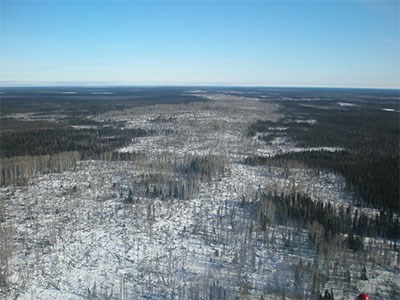KWG Resources’ ultimate dream of building a Ring of Fire railroad may have to be realized through a Chinese bank.
A spokesman for the Toronto junior miner is hyping that a “turning point” has been reached that will jumpstart the stalled development process of the untapped mineral belt in Ontario’s Far North.
KWG announced Dec. 29 that a Chinese railroad engineering firm, China Railway First Survey & Design Institute Group, is conducting a feasibility study to determine if it makes economic sense to run rails north to reach the rich chromite and nickel deposits of the James Bay region.
“The odds are extremely high,” said Bruce Hodgman, KWG’s communications director, in categorizing the likelihood of his company securing offshoring financing with a “bankable feasibility study” of KWG’s railroad concept.
“I think we’re making it happen. I think this is a huge turning point for the Ring of Fire.”
Last fall, KWG gave China Railway all-access to its technical data for a proposed chromite ore haul railway. The company is now promoting that the Chinese want to take the next step with a more in-depth study.
Besides looking for rail infrastructure money, when KWG president-CEO Frank Smeenk travels to China in mid-January to discuss the parameters of the study, he’ll be looking to secure chromite offtake agreements from the Chinese.
In return for the design and construction of a railroad, Hodgman said the Chinese could be paid in ferrochrome (processed chromite used in stainless steel production), or possibly semi-finished products.
“Do we just make ferrochrome or do we carry this further, as Frank has described in the past, and make stainless steel ingots and take it that far, or billets. Everything is on the table.”
Whether China Rail takes an equity stake in KWG will be part of the negotiations, he said.
“If we bring the financing for the Ring of Fire railway infrastructure, and we bring the Chinese in with an offtake agreement so you’re guaranteeing the market, that’s huge.”
KWG is also hoping the Chinese can help them commercialize a patent-pending chromite reduction technology that uses natural gas.
However the cold reality is that building a chromite mine in the Far North is a long way off.
KWG only holds a 30 per cent stake in the Big Daddy chromite deposit, which it shares in a litigious partnership with Noront Resources, and has the right to earn a substantial interest in another nearby chromite deposit through an arrangement with Bold Ventures.
Since the departure of Cliffs Natural Resources from Ontario last spring, no major mining company has emerged with the financial clout or a precise mineral resource calculation that would make banks comfortable to lend money to develop a mine.
However, KWG strategically possesses the best potential rail access route to reach the Ring of Fire.
In an unprecedented move in 2010, the company used mining claims to stake a 340-kilometre corridor, following a path of sand ridges, from a point on the CN main line near Nakina, north into the James Bay lowlands.
But the legality of using claims for such a long corridor has been the subject of ongoing provincial tribunal and court challenges; first by Cliffs Natural Resources and now by Noront, who acquired Cliffs’ chromite properties last spring.
Whether KWG ultimately keeps control of that staked route has yet to be decided by the courts.
“In reality, what does it matter?,” said Hodgman, dismissively. “It looks like we’re going to build a railway.
“If Noront, on the other side of the argument, decide that they want to build a road over our claims, they have to show the government they have wherewithal to build that road, and I don’t think they do. It’s irrelevant.”
However, Noront’s stated intentions are to build a road running west from Pickle Lake to reach its Eagle One nickel deposit in the Ring.
For now, KWG is promoting China Rail for its extensive experience with transit projects in its own country and its aggressive plans to export their expertise worldwide.
China Rail is leading a consortium of six state-owned businesses in joining forces with an American firm to build a high-speed rail link between Los Angeles and Las Vegas.
“They’re used to building much larger projects globally,” Hodgman said. “If they’re building on our corridor…you’re not pushing it through muskeg but on top of a sand ridge. I don’t think it’s as challenging as everybody thinks.”
KWG is still wedded to the idea of the publicly-owned Ontario Northland Railway (ONR) operating the railroad to haul out the chromite.
“It’s something we’re extremely open to and makes the most sense,” said Hodgman, “and it alleviates the need for the province to fund it (the railway).”
Hodgman said the company has always remained in “regular contact” with the ONR on their concept.




